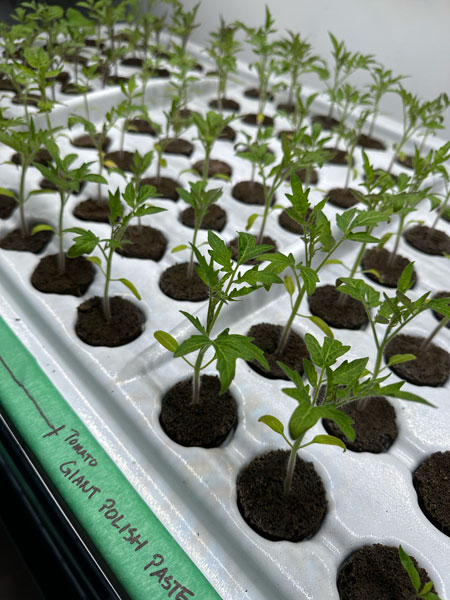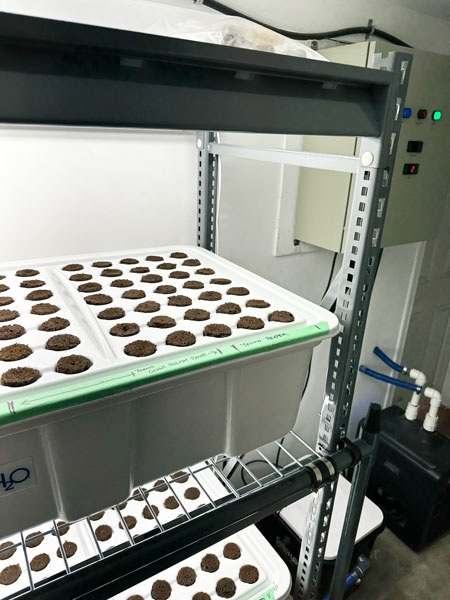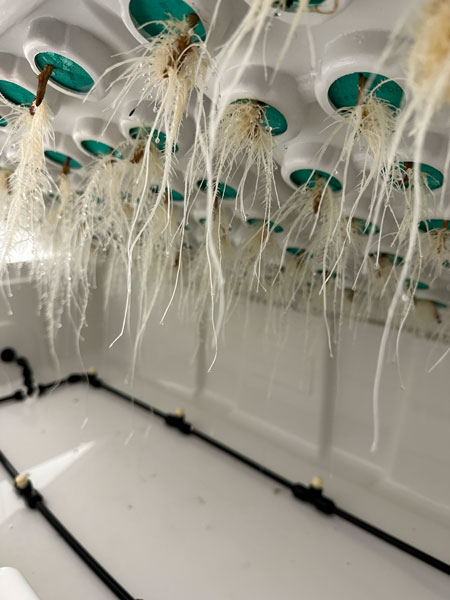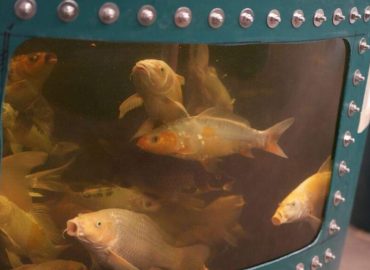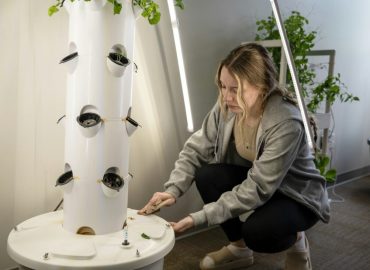High Pressure Aeroponics

Growing Crops with Nutrient Mist
High Pressure Aeroponics (HPA) is a highly efficient way to grow crops at accelerated rates using a fraction of the water and fertilizer required versus traditional growing methods. The basic principle is that plant roots are suspended in a light proof chamber and a high pressure, low volume nutrient mist is delivered intermittently to the roots in the chamber. The big advantage here is there is no growing medium to get in the way of absorption and roots are surrounded by lots of ambient oxygen. The growth response, particularly in seedlings and cuttings, is an accelerated rate of development. Systems typically operate as re-circulating so water and fertilizer use is minimal and can be charted, providing valuable metrics to growers
In contrast to other types of hydroponic growing systems, high pressure aeroponics can offer some significant advantages:
-the nutrient rich mist is typically delivered for only seconds every hour; saving on power versus continuous pumping
-little or no growing medium is required; reducing the risk of contamination in the root zone and eliminating recurring costs and disposal headaches
-because the plants roots receive a high amount of ambient oxygen, growth rates are supercharged and less fertilizer concentrations are required; improving crop quality
-the level of control over air to moisture ratios in the root zone is unparalleled
-HPA systems can be extremely light weight as they contain no growing medium or depths of nutrient solution; making them highly suited to vertical racking systems and easy handling
So Why Isn’t Everyone Using High Pressure Aeroponics?
Until more recently, the challenge for aspiring HPA cultivators has been to create a true nutrient mist (very fine particles) in a way that is reliable and cost effective. Would be aeroponic growers have often compromised by using low pressure sprayers or sprinklers rather than high pressure misters as they were less prone to clogging and don’t require specialized pumping equipment.
At Grozine, we have had the good fortune to work with Current Culture H2O’s HPAC (high pressure aeroponics cloner) to gain experience with the latest generation in high pressure aeroponics technology.
We have been blown away by the results. We are equally impressed by the ease of assembly and operation too–-the system sets up easily, with very little to connect and using light weight and sturdy components ,ie Multi Mods. The footprint of each of the grow modules is also very practical, measuring roughly two feet by four feet. This makes it easy to use widely available industrial racking systems and common horticultural lighting footprints. Standard mod lids hold 105 plants in close spacing, ideal for starting seedlings or rooting cuttings for plant cloning. Lids are also available as blanks for custom configurations so the system can be adapted for growing compact crops to maturity quickly.
Setting Up High Pressure Aeroponics
Our 210 site (two tiers, two feet by four feet) was up and running in less than an hour. In fact, most of the assembly time was for putting together the racking system; the HPAC system itself sets up very quickly once the pumping station has been mounted securely to a wall.
The pumping station draws up a small volume of nutrient solution from the remote reservoir and delivers it to the rooting chambers or grow modules under high pressure for a short period intermittently. The duration, frequency and even operating pressure come pre-set for great results. However, it is easy to customize with the digital display and push button controls.
A standard pumping station can support up to sixteen modules, so the system is very expandable–which is likely a big percentage of the initial cost as the system starts with an MSRP of $5451.95 USD. To be clear, this is a commercial or research grade high pressure aeroponics system that is made for a very long trouble free and reliable service life—it is worlds away in both performance and construction from “aeroponic cloners” that use simple mag drive pumps and low pressure sprayers.
How Fine is the Aeroponic Mist?
Incredibly fine, we would say it is closer to a fog. If directed at your hand, you will not feel the mist contacting; you simply see your hand getting wet fairly quickly. The big advantage here is surface area of nutrient delivery. Bare roots have lots of vertical space in the grow module and when coupled with the very fine spray there is a huge surface area with nothing to get in the way of plants absorbing water, oxygen and nutrients.
Operating at 80-90 psi the system is delivering an atomized spray with droplets in the particle range of 5 to 50 microns.
How Reliable is the HPAC System?
In about two months of operation only one of the misters clogged and it was replaced in seconds with one of the extra mist nozzles supplied. There are several misters in each chamber, so a single clog is not catastrophic to the crop; especially important when rooting cuttings. The misters themselves have built in filters and naturally there is an inline filter from the pumping station. We set our unit to come on for 15 seconds every four minutes and gradually widened the frequency to about 12 minutes once roots developed (and they developed fast!). Not once in two months did the system fail to deliver a cycle at the precise pressure, duration and frequency we set.
Starting Seeds with High Pressure Aeroponics
Since we can’t start seeds in thin air, we needed a small amount of substrate in the system to hold the seed until it emerges as a seedling. The iHort organic based polymer plugs supplied were outstanding in every respect. They fit perfectly in each of the planting sites and even when saturated hold a great amount of air. The texture is very sponge like; if you give them a gentle squeeze they bounce back. We feel this material outperforms rockwool or oasis for propagation purposes. Of further benefit is the fact that the material is compostable. No issues with pH or debris in the system were observed using the iHort plugs.
Plants took off fast, demonstrating very even germination from plant site to plant site. This made expensive seeds more economical to use as there were fewer duds versus traditional seeding methods. Of great benefit was the evenness in young plant development we experienced in high pressure aeroponics. This translated to more evenly developed specimens later on once transplanted into our greenhouse finishing systems (DWC, RDWC & NFT hydroponics).
We like to think we can pop seeds with the best of them, as we have for decades now–the HPAC gave us results we had not been able to achieve previously in terms of germination rates and especially in the consistency of development from plant to plant.
Rooting Cuttings with High Pressure Aeroponics
In this instance we used no substrate whatsoever, rather the PermaClone collars supplied with the system. These collars are made very sturdy and are intended for many reuses–they are dishwasher safe, can be microwaved or soaked in cleansers without deteriorating or easily harboring pathogens when reused.
We used the same operating pressure, frequency and duration for the high pressure misting cycle as with seedlings and it was highly reliable and successful. The only difference was in the reservoir, where a small amount of of K-IBA was added to stimulate root development in cut stems. No more messy or tedious cloning gels that can plug up systems or promote bacteria.
Clones developed callus tissue in around five days, started to show roots in severn days and were very well rooted within two weeks. While the rooting times were respectable (especially for a first try) the real advantage was the root mass after two weeks. Instead of a few fragile dangling spaghetti like roots, the cuttings rooted with THICK, sturdy and very well developed roots. Visually, there were at least 100% more roots than what we typically see using low pressure aeroponic cloning methods. In the future, we may quantify this by comparing the weight of root systems in high pressure aeroponic clones versus low pressure aeroponic rooted clones. Needless to say, the difference to us appeared very significant.
Growing Crops to Maturity with High Pressure Aeroponics
In the past, we would not have risked a long term crop to aeroponics simply for fear of reliability and clogging up. Not the case after our recent experience with CCH2O’s HPAC system. It’s likely we will convert an existing area in our greenhouse from NFT to a trial High Pressure Aeroponics vertical system for growing crops full term to maturity. The potential is too great to pass up based on our experiences. As always, stay tuned for more!
The post High Pressure Aeroponics appeared first on GROZINE.


